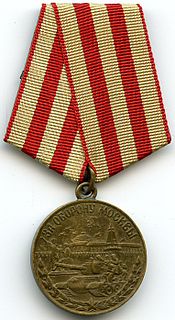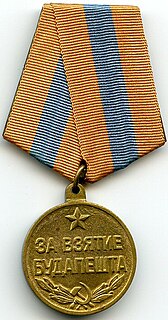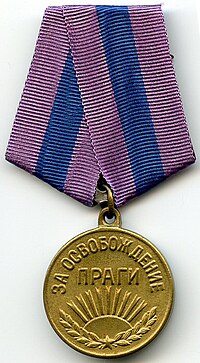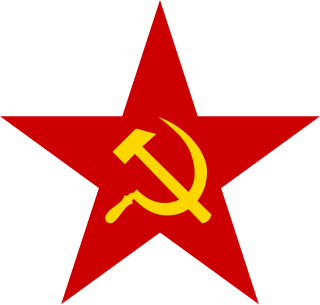
The Order of the Red Star was a military decoration of the Soviet Union. It was established by decree of the Presidium of the Supreme Soviet of the USSR of 6 April 1930 but its statute was only defined in decree of the Presidium of the Supreme Soviet of the USSR of 5 May 1930. That statute was amended by decrees of the Presidium of the Supreme Soviet of the USSR of 7 May 1936, of 19 June 1943, of 26 February 1946, of 15 October 1947, of 16 December 1947 and by decree No 1803-X of 28 March 1980.

The Medal "For the Victory Over Germany in the Great Patriotic War 1941–1945" was a military decoration of the Soviet Union established on May 9, 1945, by decree of the Presidium of the Supreme Soviet of the USSR to denote military participation in the victory of the Soviet armed forces over Nazi Germany in the Great Patriotic War.

The Medal "For the Victory over Japan" was a campaign medal of the Soviet Union established on September 30, 1945 by decree of the Presidium of the Supreme Soviet of the Soviet Union to commemorate the Soviet victory over the Empire of Japan in the Soviet–Japanese War at the end of World War II. The medal's statute was later amended on July 18, 1980 by decree of the Presidium of the Supreme Soviet of the USSR № 2523-X.

The Medal "For Distinction in Guarding the State Border of the USSR" was a military decoration of the Soviet Union established to recognise outstanding deeds related to state frontier security by members of KGB border troops, servicemen and civilians.

The Medal "For Strengthening Military Cooperation" was a military award of the Soviet Union established on May 25, 1979 by Decree of the Presidium of the Supreme Soviet. Its statute was later confirmed and slightly amended by Decree of the Presidium of the Supreme Soviet № 2523-X of July 18, 1980. It was bestowed to recognise outstanding cooperation between the different services and the different armed forces of the various Warsaw Pact countries or of any other friendly socialist state.

The Jubilee Medal "Twenty Years of Victory in the Great Patriotic War 1941–1945" was a state commemorative medal of the Soviet Union established on May 7, 1965 by decree of the Presidium of the Supreme Soviet of the USSR to denote the twentieth anniversary of the Soviet victory over Nazi Germany in World War II.

The Medal "Veteran of the Armed Forces of the USSR" was a long service award of the Armed Forces of the Soviet Union established on May 20, 1976 by decree of the Presidium of the Supreme Soviet of the USSR and awarded for twenty-five years of impeccable service to troops of the army, navy, of internal forces and of border troops. Its statute was twice amended by further decrees of the Presidium of the Supreme Soviet of the USSR, first on July 18, 1980 and lastly on January 10, 1984.

The Jubilee Medal "30 Years of the Soviet Army and Navy" was a state military commemorative medal of the Soviet Union established on February 22, 1948 by decree of the Presidium of the Supreme Soviet of the USSR to denote the thirtieth anniversary of the creation of the Soviet Armed Forces. Its statute was later amended by decree of the Presidium of the Supreme Soviet of the USSR of July 18, 1980.

The Jubilee Medal "40 Years of the Armed Forces of the USSR" was a state military commemorative medal of the Soviet Union established on December 18, 1957 by decree of the Presidium of the Supreme Soviet of the USSR to denote the fortieth anniversary of the creation of the Soviet Armed Forces. Its statute was later amended by decree of the Presidium of the Supreme Soviet of the USSR of July 18, 1980.

The Jubilee Medal "60 Years of the Armed Forces of the USSR" was a state military commemorative medal of the Soviet Union established and bestowed to military personnel to denote the sixtieth anniversary of the creation of the armed forces of the Soviet Union. It was established on January 28, 1978 by decree of the Presidium of the Supreme Soviet of the USSR. Its statute was amended by decree of the Presidium of the Supreme Soviet of the USSR on July 18, 1980.

The Medal "For the Defence of Leningrad" was a World War II campaign medal of the Soviet Union established on December 22, 1942 by decree of the Presidium of the Supreme Soviet of the USSR to recognise the valour and hard work of the Soviet civilian and military defenders of Leningrad during the 872-day siege of the city by the German armed forces between September 8, 1941 and January 27, 1944. The medal's statute was later amended by Resolution of the Presidium of the Supreme Soviet on March 8, 1945. and again one last time on July 18, 1980 by decree of the Presidium of the Supreme Soviet of the USSR № 2523-X.

For the Defense of Moscow was a World War II campaign medal of the Soviet Union awarded to military and civilians who had participated in the Battle of Moscow.

The Medal "For the Defence of Kiev" was a World War II campaign medal of the Soviet Union established on June 21, 1961 by decree of the Presidium of the Supreme Soviet of the USSR to be awarded to the participants of the defence of the city of Kiev during the 1941 invasion of the USSR by NAZI Germany.

The Medal "For the Capture of Berlin" was a World War II campaign medal of the Soviet Union established on June 9, 1945 by decree of the Presidium of the Supreme Soviet of the USSR to satisfy the petition of the People's Commissariat for Defense of the Soviet Union. The medal's statute was amended on July 18, 1980 by decree of the Presidium of the Supreme Soviet of the USSR № 2523-X.

The Medal "For the Capture of Budapest" was a World War II campaign medal of the Soviet Union established on 9 June 1945 by decree of the Presidium of the Supreme Soviet of the USSR to satisfy the petition of the People's Commissariat for Defense of the Soviet Union to recognise and reward the participants of the battle for the capture of the city of Budapest from the armed forces of Nazi Germany. The medal's statute was amended on 18 July 1980 by decree of the Presidium of the Supreme Soviet of the USSR № 2523-X.

The Medal "For the Capture of Königsberg" was a World War II campaign medal of the Soviet Union established on June 9, 1945 by decree of the Presidium of the Supreme Soviet of the USSR to satisfy the petition of the People's Commissariat for Defense of the Soviet Union for recognition of the participants of the battle to capture the city of Königsberg from the armed forces of Nazi Germany. The medal's statute was amended on July 18, 1980 by decree of the Presidium of the Supreme Soviet of the USSR № 2523-X.

The Medal "For the Capture of Vienna" was a World War II campaign medal of the Soviet Union established on June 9, 1945 by decree of the Presidium of the Supreme Soviet of the USSR to satisfy the petition of the People's Commissariat for Defense of the Soviet Union to reward the participants of the battles for the capture of the city of Vienna from the armed forces of Nazi Germany. The medal's statute was amended on July 18, 1980 by decree of the Presidium of the Supreme Soviet of the USSR № 2523-X.

The Medal "For the Liberation of Belgrade" was a World War II campaign medal of the Soviet Union. It was established on June 9, 1945 by decree of the Presidium of the Supreme Soviet of the USSR to satisfy the petition of the People's Commissariat for Defence of the Soviet Union.

The Medal "For Impeccable Service" was a Soviet military award for long service awarded to deserving members of the military personnel of the armed forces of the USSR, of the Interior Ministry of the USSR and of the Ministry for the Protection of Public Order of the USSR, to recognise ten, fifteen and twenty years of faithful and impeccable service to the state.



























